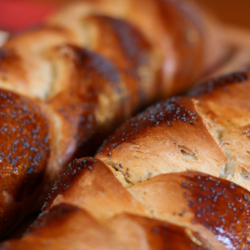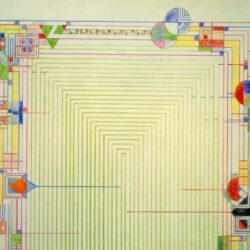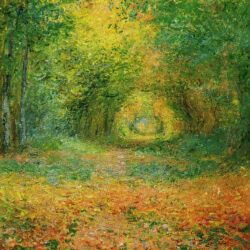| Contribute a translation | Source (English) |
|---|---|
A Kavannah and Prayer | |
What was the seder table when we only had Elijah’s cup? Incomplete. | |
We open the door for Elijah, Angry prophet of the world to come. And we ask God to pay attention To the fire from the sky that was Elijah’s gift. Regretted necessity. Elijah announces the Moshiaḥ Who then saves the Jews! Elijah, the bringer of justice. When you open the door don’t just say the prayer Read the translation, It’s a little scary So invite that in. Bring down the anger, bring down the plagues Sometimes we need them, It’s part of the story. We were slaves in Egypt and it was horrible. But If there is a child at the table Let her open the door for Uncle Elijah And hope that there’s some wind tonight And when it blows Tell her that’s Elijah as he comes inside Visiting each Jewish home on Pesaḥ To have his cup of wine. And when the child sits back down Jiggle the table just a little And tell her to watch the wine shake in the cup So the kid thinks Elijah is there, taking a sip. The anger will wait. | |
We lift Miriam’s cup, Dancing prophet celebrating the world that is now. And we tell God we are grateful For the water from the earth that was Miriam’s gift, Welcome necessity, On God’s behalf. Miriam announces joy! And teaches us to save ourselves. Miriam, the bringer of mercy, There’s no prayer for her in the haggadah— So make one up! It’s a little scary But what the heck. Bring up the water, start the party Sometimes we need it And it’s part of the story: We were slaves in Egypt and now we are free. But If there is a child at the table Let him take a sip from Miriam’s cup, If all the talking makes him thirsty, And while he drinks Tell him about Miriam the artist Singing Mi Ḳhamoḳhah on the Red Sea Shore Making sure we have fun at the table. And when the child is finished Remember that Miriam was a truth teller And for that the prophet paid a heavy price Make sure the kid respects Miriam, and values her water. The fun will wait. | |
So together on the seder table Fire and Water, Justice and Mercy Tzedek v’ Raḥameem, The cup of wine to stir the flame The cup of water to quench it. Only with both cups are we complete. So for all this, Baruḳh Atah Adonai, Bruḳha At Sheḥinah Elijah and Miriam We are blessed this Pesaḥ night. Amen. |
Trisha Arlin’s prayer-poem for Pesaḥ, “Two Cups: Elijah and Miriam,” was first published online on her website, with a CC-BY-SA 3.0 Unported license.

“Two Cups: Elijah and Miriam, a kavvanah and a prayer by Trisha Arlin” is shared through the Open Siddur Project with a Creative Commons Attribution-ShareAlike 4.0 International copyleft license.







![Ancient Mud-Brick Wall [citadel of Rayen, Iran] (credit: A. Davey, license: CC BY)](https://opensiddur.org/wp-content/uploads/2025/03/ancient-mud-brick-wall-citadel-of-rayen-iran-a--davey-cc-by-250x250.jpg)


See this thread on David A.M. Wilensky’s blog for a great ritual to correspond with the filling and use of the cups of Miriam and Elijah. A commenter named Rich, writes:
Poetic license aside, the idea of a sixth cup attributed to Miriam is troubling (non-sensical?).
There is a debate as to whether we should have four or five cups at the seder. The source for four cups is the rabbinic reading of the verses, Exodus 6:6-7 (jointly comprising one grammatical sentence), which contain four expressions of redemption or redemptive action that G-d will take. There is a fifth expression of redemption in the immediately subsequent verse, 6:8, hence the dispute between either 4 or 5 cups. Six is not an option. The four cups also correspond to four junctures in the haggaddah where one would make a blessing on wine: (1) the kiddush, (2) the beginning of the mean, (3) the end of birkat hamazon, and (4) the end of Hallel. As for the attribution of the doubtful fifth cup to the Prophet Elijah, the source for this is not clear. One explanation is that Elijah presides over bris milah (hence the custom to have an empty chair next to the baby at the bris ceremony) and all Jews required circumcision before they would be redeemed. Another explanation is that as we recall the prior redemption, we also invoke and look forward to the future redemption which will be heralded by Elijah.
Miriam is not a character in the seder. Nor is Moshe for that matter–his name is not even mentioned in the Hagaddah (i.e., the entire story of the exodus is told without mentioning Moshe… pretty amazing). So, I’m not sure why we would put Miriam in a more prominent role than Moshe. Mrs. Arlin should check her sources.
I’m not sure I appreciate the rest of the poem. It seems to include a lot of agnst, and possibly anger, which would not be a good emotional or intellectual approach for introducing children to Judaism at the seder.
To be clear, Andy, the custom of including a cup for Miryam in addition to the cup for Eliya is not Trisha Arlin’s. According to the website, Miriam’s Cup:
Your point is well taken concerning the important absence of Moshe in the particular narrative offered in the traditional Pesaḥ Haggadah, and this absence would certainly apply to other charismatic figures present in the story of the journey out of Mitzrayim and through the Midbar.
But to better understand this custom of including a cup of Miriam, it’s important to understand the yearning the custom gives expression to. It is also a way of drawing attention to the importance of Miriam and the other women of the Exodus story, women who have sometimes been overlooked but about whom our tradition says, “If it wasn’t for the righteousness of women of that generation we would not have been redeemed from Egypt” (Babylonian Talmud, Sotah 9b). The cup of Miriam itself represents not Miriam but the well provided to Bnei Yisrael in her merit to quench their thirst throughout their journey in the Midbar (Babylonian Talmud, Ta’anit 9a).
This custom is certainly a ḥiddush, but inarguably, it’s an innovation which was made in the spirit of the mitzvah of Pesaḥ — to imagine oneself drawn out of Mitzrayim. The symbolism of the well and it’s deep association with the merit of Miryam and the Banot Yisrael, provides for a fascinating justification for those seeking to enrich the experience of the seder for themselves and their children . Certainly, it will inspire questions of adults and children alike, and what more can one ask for besides a joyous and kosher Passover journey?
The term “kos shel Eliyahu” is actually misleading. It is not for him to drink and not even in his honour. The reason Eliyahu got mixed into this is exactly because we don’t have an agreement on the 4 or 5 cups question. This situation is known as TEK”U, a term also used by modern Hebrew speakers for a tie in a game. A TEK”U is an acronym (or maybe a backronym) for Tishby will solve questions and problems, meaning that in the future, when Eliyahu (the Tishby) comes back to earth to announce the coming of Mashi’ach, he will also reveal the solution for those tied questions. I can see why one would want to add a female figure to the sedder etc., but the whole structure is built in midair on a strange Jewish parallel to St. Nick (wonder why Christians never gave him a female companion/alternative yet…).